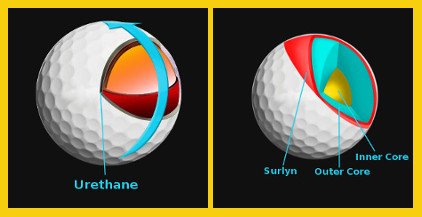
In golf, the term “ball cover” refers to the outermost layer of a golf ball. The cover is the part of the ball that makes contact with the clubface during a golf shot and influences the ball's spin, feel, and durability.
There are two primary materials used for golf ball covers: urethane and surlyn.
- Urethane Cover: Urethane covers are typically found on higher-end golf balls and are known for their soft feel and high spin rates. They provide excellent control and greenside performance, allowing skilled golfers to generate more spin and have better shot-stopping ability on the green. Urethane-covered balls are often preferred by professionals and low-handicap players who prioritize precision and control.
- Surlyn Cover: Surlyn is a durable ionomer resin material commonly used in the covers of lower-priced and recreational golf balls. Surlyn covers are more resistant to scuffs and cuts, making them more durable and longer-lasting. These balls tend to have a firmer feel and generate less spin than urethane-covered balls. Surlyn-covered balls are popular among beginners and high-handicap players who seek distance and durability.
The choice between a urethane or surlyn cover depends on the golfer's skill level, playing style, and personal preferences. Skilled golfers who place a premium on feel and control may opt for a urethane-covered ball, while those seeking durability and distance may prefer a surlyn-covered ball.
It's important to note that the cover material is just one factor that affects a golf ball's performance. Other factors such as the core construction, dimple design, and compression also play significant roles in determining the ball's flight characteristics, spin rates, and overall performance.
Golf ball manufacturers continue to innovate and develop new cover materials and designs to optimize performance for different players and playing conditions. Therefore, it's always beneficial for golfers to try out different ball models and find the one that suits their game best.
Cover of a Golf Ball: The ball’s outer layer. Typically made from urethane or a material called Surlyn, the cover is dimpled and has a major effect on the ball’s performance characteristics.






